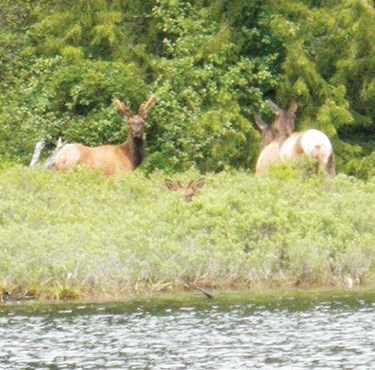It took about a century, but Roosevelt elk are back in the Lower Mainland.
There have been numerous sightings this summer near Lougheed Highway at Kanaka Creek Regional Park.
“It was kind of like Bigfoot or yeti,” 18-year-old Douglas College student Luke Tengs recalled in an interview Monday. “Elk in Maple Ridge? Really?”
Tengs was driving home to Maple Ridge after getting gas in Mission at 9:30 p.m. on Aug. 6 when he spotted two bull elk on the north side of the bustling four-lane Lougheed Highway.
“At first, it looked like two men carrying big boxes on their heads. I did a double take. That’s not two men. That’s elk right there.”
He drove home, got his camera and returned to capture some images.
The return of the majestic Roosevelt elk is generally being well-received by provincial officials.
Darryl Reynolds, a senior wildlife biologist with the Ministry of Forests, Lands, and Natural Resource Operations, said the coastal elk were hunted out of the Lower Mainland “very near to the turn of the [last] century.”
Of their return, he said: “They’re dispersing and repopulating, and that’s fantastic. The whole area, the Fraser Valley lowlands, used to be loaded with elk. It’s an indication of the success of our program.”
These particular elk are thought to have wandered down from the upper Stave or upper Pitt watersheds.
Twenty elk were reintroduced to the Stave in 2006-07, and 23 elk to the Pitt in 2004-05 as part of a larger ongoing provincial program to return the species to southwestern B.C., with funding assistance from the provincial Habitat Conservation Trust Foundation.
Another 17 elk were released last winter to Harrison Lake, with more to come this winter. A productive herd on the Sunshine Coast is serving as the source population for the ongoing relocations.
The sudden presence of such a large mammal does pose a risk to unwary motorists, confirmed Reynolds, who has notified the ministry of transportation. “Wherever you’re driving, be vigilant. You never know what will be on the road ahead of you.”
The Roosevelt, named after the late U.S. President Theodore Roosevelt, is the largest of six sub-species historically found in North America, with males weighing up to 400 kilograms.
People should also keep their distance from the elk, and keep dogs on a leash.
“Kanaka Creek is a little oasis for elk in the middle of a concrete jungle, one of few places suitable to them,” Reynolds noted.
He expects the two bulls will head back into the wilderness for mating season, and may have already left. Over the long term, he doesn’t see a major place for elk in such a populous region.
“We’ll be encouraging the elk to the stay in the mountains, where there is an abundance of habitat and they won’t get into conflicts.”
